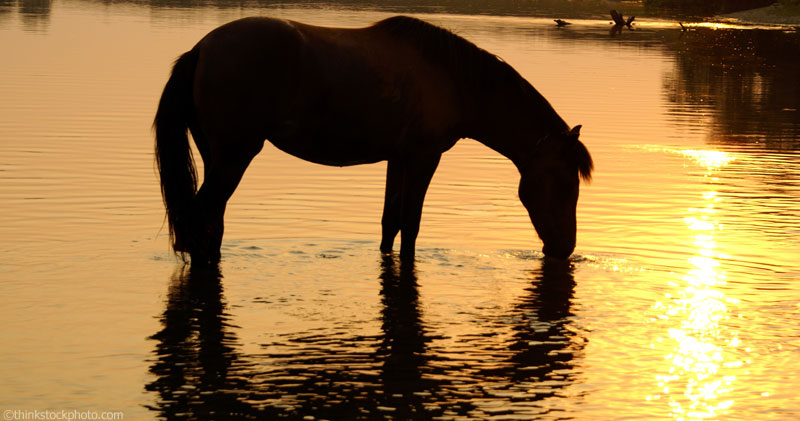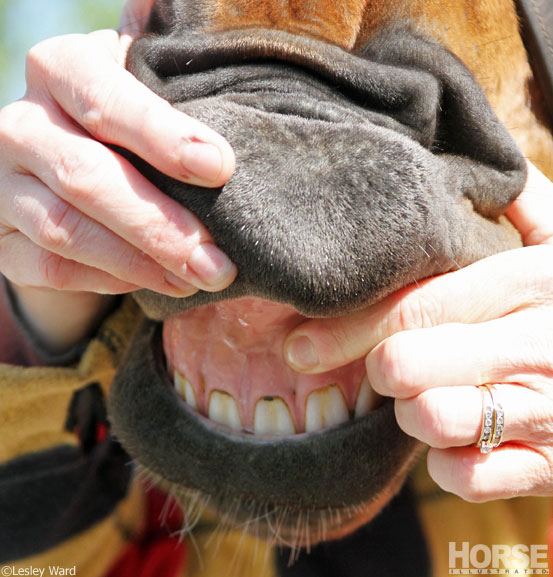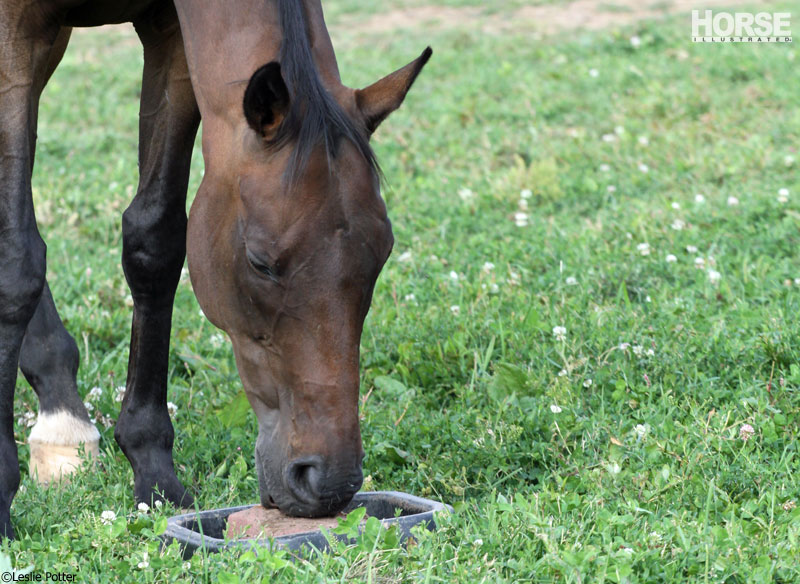Along with the fun-filled hours of summer riding comes the responsibility of keeping your horse properly hydrated in the heat. Horses, like humans, produce sweat from glands all over their body. As sweat evaporates, the skin cools and helps moderate overall body temperature, preventing overheating. Sweat is made up not only of water, but also electrolytes, most notably sodium and chloride—the two components of salt—and to a lesser extent, potassium, calcium and magnesium. Therefore, when a horse sweats, he loses these important elements to the environment.

The amount of water a horse actually needs is highly variable, depending on his size, the ambient temperature and humidity, and the horse’s activity level. In cooler months, a horse at rest can drink 5 to 12 gallons of water a day. This will go up considerably during the hot summer months when activity increases.
When the rate of water and electrolyte loss outweighs the horse’s internal balance of these nutrients, he becomes dehydrated. Interestingly, horses do not respond to sweating with increased thirst the way humans do. This is because human sweat contains a greater amount of water than electrolytes. When we sweat, our internal fluid balance becomes overloaded with electrolytes such as sodium due to the excessive loss of water, and as a response, we feel thirsty. In contrast, equine sweat contains a more equal balance of electrolytes and water, which dampens the thirst response even if the horse is dehydrated. This is why sometimes you can lead a hot horse to water and he won’t want to drink.
Hidden Dangers of Dehydration
Dehydration is dangerous in that it can be hard to observe. Mild dehydration may easily go unnoticed but can quickly progress if the horse is not rested and offered a chance to hydrate. A decrease in a horse’s athletic performance is sometimes the first sign of significant dehydration: The proper balance of water and electrolytes is necessary to promote healthy muscle and nerve function.
Horses suffering from severe dehydration may have muscle twitches or a condition called “thumps.” Also known as synchronous diaphragmatic flutter, thumps is a condition seen occasionally in endurance horses and is characterized by a thumping noise and a twitch visualized along the abdomen in front of the flank. It’s caused by dehydration coupled with low blood calcium. The condition isn’t life threatening and disappears when the horse’s dehydration and electrolyte imbalances are corrected.
|
As dehydration worsens, the kidneys can become affected, and if left untreated it will lead to multiple organ failure. More commonly, severe dehydration can lead to colic or tying-up, a painful muscle condition medically referred to as rhabdomyolysis, which occurs when muscle tissue begins to break down. These conditions can be life threatening.
Drink up
Preventing dehydration is often the best strategy when working with your horse in the summer. First and foremost, he should have free access to clean, fresh water. Understandably, this is easiest to accomplish at your own stable. But how can you help ensure your horse drinks enough when at a show or out on the trail?
Many horse owners have experienced the frustrating situation when a horse refuses to drink any water at a show. Horses can develop a taste for their “home” water, and any water from another source will elicit an upturned nose. Obviously this can turn into a health concern during a weekend away from home.
One way to combat this problem is to alter the taste of your horse’s water a few days prior to leaving home. Apple juice, a few drops of peppermint extract, or a small amount of Gatorade are easy choices that can change the taste of the water enough to hide any differences between your horse’s stable water and water at a show. Just remember to bring the additive with you to the competition! Bringing your own water from home is also an option, although large portable containers can also change the taste.
When at a show, don’t restrict your horse’s water intake. Offer fresh water after each class and have a bucket available when your horse is tied up. Also try to have your horse stand in the shade whenever possible. If the ambient temperature is considerably hot—upwards of 90 degrees—or if the humidity is high, repeated sponging or cold-water hosing will help keep your horse cool too. If you decide to do this, be sure to scrape the excess water off. Residual water left on the horse will quickly heat up to his body temperature and act as a heat insulator instead.
On long trail rides, try to plan your routes near running water, such as a creek or river. Offer breaks where your horse can drink or graze on grass that contains considerable moisture.
After a long ride or heavy competition, don’t prevent your horse from drinking water. However, control his intake so that he doesn’t consume a large amount within a matter of minutes. Dehydration can cause ileus, or a lack of gut motility. If a dehydrated horse suffering from ileus is allowed to gulp gallons of water within a short period of time, this may cause painful gastric distension that could lead to gastric reflux.
Instead, offer roughly a quarter of a bucket of water at a time. When this amount has been finished, wait a few minutes and then offer your horse more of the same amount. Repeat until he doesn’t want to drink anymore, and then offer a full bucket for him to drink at his leisure.
Signs of Dehydration
Knowing how to identify dehydration is also important. Horses with moderate to severe dehydration will have an elevated heart rate with a weak pulse. Gums will feel dry, and capillary refill time—the time it takes for the gums to return to a pink color after applying finger pressure—will be longer than three seconds.

A dehydrated horse’s capillary refill time will be longer than three seconds. Photo: Lesley Ward
Skin tenting is another indicator of dehydration. You can assess this by pinching skin on your horse’s neck. In an adequately hydrated horse, the skin will pop back flat almost immediately. In a dehydrated horse, the skin will remain tented for a period of time. Severely dehydrated animals may have skin that takes many seconds before it returns to normal.
The color of a horse’s urine will also help you assess hydration status. The more dehydrated a horse is, the darker his urine will be.
Just estimating how much your horse is sweating is not a good indicator of how dehydrated he may be. Ambient humidity has a considerable influence over the amount of sweat you will see on your horse; very dry days or high-altitude locations can cause sweat to evaporate fast enough that a horse can appear relatively dry even after heavy exercise on a hot day.
Electrolytes
What about restoring electrolyte loss? Simply supplying a dehydrated horse with water will not replenish lost sodium and chloride. There are numerous additives found in most feed stores that are formulated to help replenish your horse’s electrolytes. If a horse is receiving a well-balanced diet of quality forage and/or a pre-mixed concentrate ration specific to his age and training level, adding electrolytes to the water or feed is not generally necessary during or after mild to moderate exercise in the summer. Access to a salt or mineral block also helps take care of any minor depletion a horse may experience during the hot months.

Offering your horse a salt or mineral block can help restore any minor electolyte depletions from mild to moderate exercise. Photo: Leslie Potter
In contrast, for horses repeatedly undergoing intensive work in the heat—such as racing, endurance rides, or lengthy training sessions—supplementation with an electrolyte mix (available in paste and powder) is warranted. When offering a water additive to your horse, always be sure to provide another bucket of plain water to give him a choice.
It is important to note that you can’t pre-load a horse with electrolytes because they will be excreted in his urine. Offering an electrolyte mix to your horse the day before a demanding event will not be of any benefit.
You Can Lead a Horse to Water…
Horse owners address many cases of mild dehydration intuitively with common sense. But what should you do if you have a dehydrated horse that won’t drink? If a horse appears anxious or exhausted either during or after a physically intense workout, refuses water and exhibits symptoms of dehydration, call your veterinarian. Severely dehydrated horses can sometimes require numerous liters of fluids to replenish their losses, and your vet can administer this volume most efficiently via intravenous (IV) fluids. Your vet can also draw blood samples for analysis to determine how badly your horse’s electrolytes are unbalanced. This information can help tailor IV fluid therapy specifically to your horse’s needs.
Most horses recover quickly from dehydration and electrolyte loss. Hydration, rest and the opportunity to cool down work wonders for managing a horse on a hot day. Understanding the basics of hydration will keep your horse happy throughout the summer.
Liked this article? Here’s more on hot-weather health:
Question of the Week: Correctly Cooling Out
10 Tips to Stay Safe with Your Horse in Hot Weather
Supplemental Salt Can Help Your Horse in Hot Weather
ANNA O’BRIEN, DVM, is a large-animal ambulatory veterinarian in central Maryland. Her practice tackles anything equine in nature, from Miniature Horses to zebras at the local zoo, with a few cows, goats, sheep, pigs, llamas and alpacas thrown in for good measure.
This article originally appeared in the July 2014 issue of Horse Illustrated. Click here to subscribe.






informative
cool
Timely advice.
great info, very important
I was always told salt blocks are for cows. I have also been told the mineral blocks that are high in iron are not a good thing. I have one horse who can eat a five lb. block in about 24 hours and then we deal with the diarrhea. Our salt with iodine is given in their daily ration.